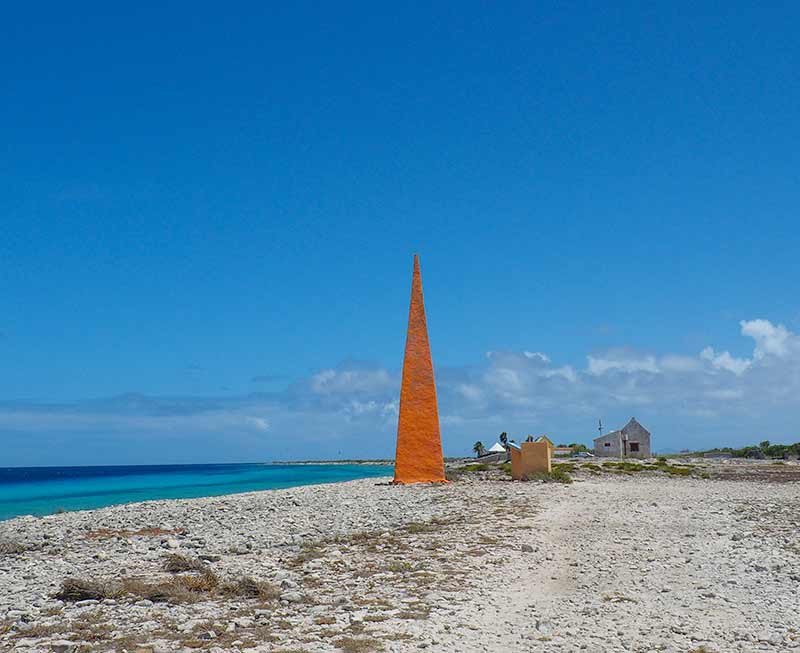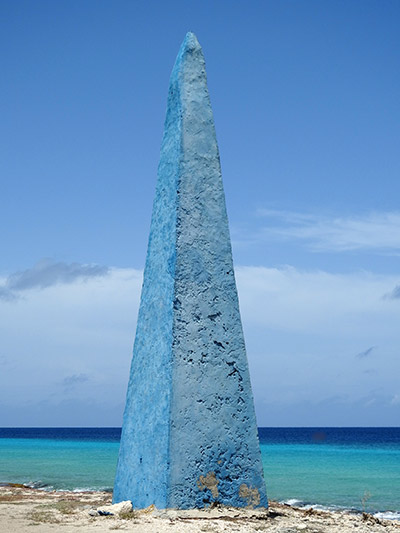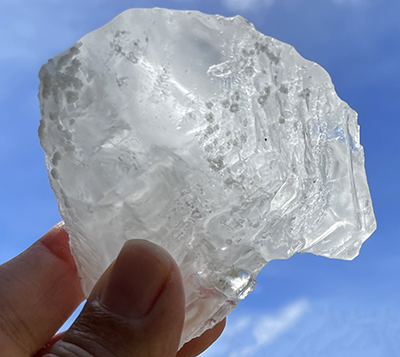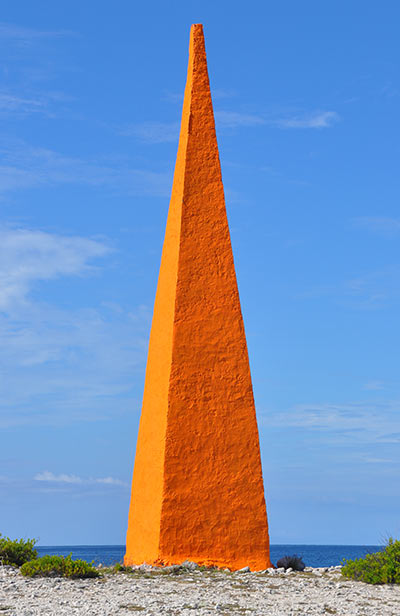Learn the story behind why Bonaire’s historic obelisks were built.
Driving southward along Bonaire’s leeward coast is a popular activity, no matter if the reason is purely sightseeing, diving, snorkeling, or birdwatching. The southern region of Bonaire, around the Pekelmeer (the salt ponds), is a favorite area for both visitors and residents alike.
Bonaire has four authentic, historic obelisks.
As one drives southward, four obelisks of different colors will be encountered at various locations on Bonaire’s southwestern shoreline. They are obviously old, but why were they built and what do they signify?
The colors of Bonaire’s historic obelisks.
 The island of Bonaire was already in the hands of the Dutch when the obelisks were constructed after 1816, and so the colors of the four obelisks are red, white, blue, and orange. The red, white, and blue obelisks represent the colors of the Dutch flag, while the orange obelisk represents the Dutch Royal Family, the House of Orange-Nassau (Dutch Language: Huis van Oranje-Nassau), the current reigning house of the Netherlands.
The island of Bonaire was already in the hands of the Dutch when the obelisks were constructed after 1816, and so the colors of the four obelisks are red, white, blue, and orange. The red, white, and blue obelisks represent the colors of the Dutch flag, while the orange obelisk represents the Dutch Royal Family, the House of Orange-Nassau (Dutch Language: Huis van Oranje-Nassau), the current reigning house of the Netherlands.
The blue obelisk.
When traveling southward from Kralendijk, the first obelisk you will encounter is the blue one, situated right at the Salt Pier, a popular dive site. Back in the 1800s, this obelisk marked the location of “Blauwe Pan,” one of the salt ponds in use at that time (and still in use today) for the crystalizing of sea salt for export, mainly to the Netherlands. There, salt was considered a very valuable commodity and was used to preserve the much-loved herring, caught in the North Sea during the summer months.
The white obelisk.
The white obelisk marks the location of the “Witte Pan” crystalizing pond, which is now east of Pink Beach. Today it is known as White Slave, and it is also the location where the first set of slave huts can be explored. Although a working pond in the 1800s, today the pond marked by the white obelisk is left natural for the island’s nature, and, indeed, Bonaire’s iconic flamingos make use of it today.
The red obelisk.
Similar to the white obelisk, the red obelisk marks the location of a crystalizing pond that is no longer in use today for salt production. The “Rode Pan” was marked by the red obelisk when this area was active in salt production.
The orange obelisk.
Located quite close to the red obelisk, the orange obelisk also marked a salt crystalizing pond which today is left natural for Bonaire’s fauna. The red and orange obelisks can be seen at what today is known as Red Slave, and this is where another set of slave huts is located. Look carefully into the ponds, and you can see the remnants of the small “dikes” or walls that once upon a time separated the ponds, so they could be kept at different levels of water and a steady supply of salt was always ready to harvest. Today, Bonaire’s salt production and harvest is a “well-oiled machine” managed by Cargill. It is interesting to stop and watch as they create Bonaire’s famous salt mountains.
The real reason why Bonaire’s historic obelisks were constructed.
But why go through all the trouble of constructing these obelisks just to mark the locations of various working salt ponds? There is a better reason! In the days of the old cargo sailing ships, there were not VHF radios or mobile phones, in fact, there was no communication at all! So where should the captain of a cargo sailing ship go to onload his salt cargo?
The ships would first sail into the Bay of Kralendijk. There, the fort would be flying a flag in one of the colors red, white, blue, or orange. Without having to come ashore, the captain would know immediately where he should sail to pick up his salt cargo.
Today, we find the obelisks more decorative than functional, but still, to this day, many leisure sailors will use them to visually know exactly where they are on Bonaire’s southwestern coast.
(Source: Bonaire Insider Reporter)











